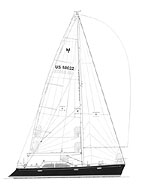Firefly
Racer-cruiserr
Let's start out with this mysterious sailplan. I called Chuck to ask him why the minimal headstay offset. Why not just make this a masthead rig instead of a 15/16ths rig as drawn? Chuck gave me various nebulous reasons why fractional rigs had performance advantages, but I don't question that. What I do question is the performance advantage of this tiny offset.
In this case I would have liked to see at least the spinnaker hoist go to the masthead. But this spinnaker is just above the hounds and still about 10 inches short. To my eye this looks to be a sailmaker's decision. Having said all that, this is still a very handsome boat and that's what we would expect from Chuck Paine.
The SA/D is 21.36. Note that both a racing mainsail and a cruising main are drawn. The cruising main is slightly shorter on the hoist and has less roach. Mast and boom are carbon fiber from GMT. The shrouds are in-line and runners and checkstays will be required to keep this mast in column.
The hull lines show a boat with short ends and a long sailing length. There is a hint of hollow in the entry and the forefoot sections have deadrise. This deadrise carries through the entire length of the boat and almost fairs out to a tangent at the transom, but not quite. The keel is a large planform fin-and-bulb type with an upper fin portion made of welded 316L stainless steel. It is imperative if you are chasing modern performance speed targets that you do a keel like this. There is no substitute for a low VCG.
The D/L for this design is 146 and that puts this design in the slightly lighter than moderate category. The rudder is a huge, carbon fiber semi-balanced spade with what looks to be about a 20 percent balance area. I like big rudders. I have never had a client call and tell me his rudder was too big. With the prop forward and this clean run, this boat should back up under power like a dream.
This is a very conventional interior layout and close to perfect in my book. The galley is large with plenty of counter space. There is counter space on each side of the sink and each side of the range. You need counter space to hold pots on while you are cooking. The ice box is located where crewmembers can get their own beverages without disturbing the cook.
The saloon is down a step with settee berths flanked by pilot berths. I presume there could be a V-berth filler to convert the forward V-berths into a double. The aft stateroom has quarter berths and an athwartships berth section that I think is designed to allow you to use it as a double berth. Maybe it's just a place to throw sails. This is a simple and effective layout.
Chuck's notes call this an "heirloom quality" yacht. I think that is fancy talk for a structurally durable boat designed to pursue that timeless target of comfort and speed. Quality design combined with quality construction always manages to remain in style. This one's a keeper. It will be fun to see what this design can do on the race course.

Comments